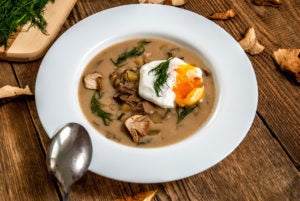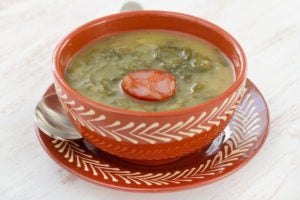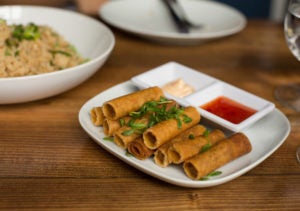This article originally appeared on Konversai's blog, The Social Movement.

We all know that one of the best ways to get to know a new culture while traveling is through food. The way in which people prepare and enjoy food sheds light on cultural values and practices. While it is advisable to keep an open mind when it comes to food and to try new things whether or not you’re traveling, this is often easier said than done. It is especially difficult to be adventurous with new foods when you have certain dietary restrictions, including being vegetarian.
The definition of vegetarian varies across people and cultures. For the purposes of this blog, a vegetarian diet refers to one that does not include any animal flesh. Those who follow a vegetarian diet do so for a variety of reasons, including moral/ethical reasons, environmental reasons, and health reasons, among others. While there are numerous benefits associated with a vegetarian diet, being vegetarian can pose a major challenge when traveling in countries where vegetarianism might be unheard of let alone uncommon. Some people choose to relax their dietary restrictions when they travel in order to get an authentic experience of the local cuisine, while others prefer not to. But is it possible to still get an authentic experience of the local cuisine while still adhering to a vegetarian diet? Even in meat-centric cuisines, not every single dish will contain meat. A little bit of creativity and research on local produce is sure to help you find a meal that is both reflective of the region and suitable to your taste buds and dietary needs.
In this blog, we explore typical vegetarian dishes that you can find in countries with stereotypically meat-centric cuisines. Specifically, we’ll be looking at Argentina, Peru, Brazil, Germany, Poland, France, Czech Republic, Portugal, Spain, Romania, Bolivia, Russia, and the Philippines. By following the vegetarian travel guide below, you can both survive and thrive while roaming around the world!
Argentina
In Argentina, “meat” often just refers to “beef,” so if you were to say sin carne (without meat), you might still be presented with options that contain pork, poultry, and fish. If you are a strict vegetarian, you will have to specify that you don’t want any of the aforementioned products. You can often ask to switch meat with boiled eggs, arugula, beets, or beans. While vegetarianism is becoming more fashionable in Argentina, its cuisine still comprises quite a bit of meat.
On another note, because there are many Italian immigrants in Argentina, vegetarian pizzas and pastas are common. Below is a list of other vegetarian dishes you can find in Argentina.

Empanadas: An empanada is a baked or fried bread or pastry that can contain any number of fillings. Some typical vegetarian-friendly empanadas include verdura (Swiss chard and white sauce), choclo/humita (corn and white sauce), and queso y cebolla (cheese and onion).
Milanese de Soja: A soy version of the classic Milanese, or thinly sliced breaded and fried cutlets of beef, chicken, or pork. You can also get sliced eggplant in place of the meat.
Medialunas: Literally translated as “half-moons,” medialunas are croissants, which you’ll find as a breakfast option in hotels and hostels. Sure, they might not be the most nutritious option, but they are delicious, and definitely vegetarian. Make sure you ask for it with butter and not lard.
Humitas: Humitas are basically vegetarian tamales. It is a mix of corn, cheese, and onions which are wrapped in a corn husk and boiled.
Quinoa: Quinoa is a high-protein, grain-like food that originated in the Andean region and was sacred to the Incas. Quinoa-based dishes are especially common in higher-altitude towns and cities, such as Cachi and Purmamarca.
Provoleta: Ooey, gooey, cheesy goodness. Need we say more?
Tartas Saladas: Similar to empanadas, tartas saladas are pastries or pies with savory fillings. Common vegetarian fillings include corn, onions, spinach, hard-boiled eggs, and pumpkin.
Morrones Rellenos: Peppers stuffed with blue cheese, onions, leeks, and carrots. You can also get stuffed squash.
Fainá: Garbanzo flour, water, olive oil, and shredded cheese.
Peru
Peru is home to over 4000 different types of potatoes, and potatoes are major staple in Peruvian cuisine. For this reason, many of the vegetarian dishes listed below are potato based.

Causa: Layers of Peruvian yellow potatoes alternated with layers of fillings. Vegetarian fillings can include vegetables, yams, and cheese, among others.
Rocoto Relleno: Translated to “stuffed peppers,” rocoto relleno can include both vegetarian and meat fillings. Typical vegetarian fillings include boiled eggs, cheese, red onions, and garlic.
Papa a la Huancaina: Usually served as a starter, this dish consists of boiled yellow potatoes served on lettuce leaves with boiled eggs, olives, and corn and smothered in a spicy, creamy cheese sauce.
Escribano Arequipeno: A potato salad dish made by mashing together potatoes, rocoto peppers, and tomatoes.
Papas a la Ocopa: Another common starter, this dish comprises boiled potatoes smothered in peanut sauce and is served with salad and fried cheese.
Empanadas: See description in Argentina above.
Locro de Zapallo: Locro is a stew that is common in the Andean region. While most of the time, locro is made with meat, locro de zapallo is made with butternut squash stewed with corn, potatoes, onions, and garlic and finished with herbs, red pepper sauce, and cream.
Arroz al Olivar: This rice dish is usually served as a side to meat dishes, but it can also be eaten by itself. The rice is cooked with olives, onions, and evaporated milk and is seasoned with garlic, salt, and pepper.
Pastel de Alcachofa: Basically, an artichoke quiche without the crust. This dish is made with breadcrumbs, eggs, and cheese.
Huevos a la Rabona: Fried eggs on top of a slice of fried bread garnished with onions and chili peppers. Usually served as a breakfast.
Chupe de Habas: A cilantro-flavored vegetable soup containing potatoes, fresh beans, onions, cheese, and eggs. While it’s usually served as an appetizer, many people find it filling enough to eat as a meal.
Puchero: This is a stew frequently served during festivals in Peru. Most of the time it is made with beef or pork, but there is a vegetarian version that contains corn, peas, carrots, and potatoes.
Crema de Tarwi: Tarwi is a legume that is grown in the Andes region of Peru. Crema de tarwi is a creamy soup made with tarwi.
Purtumute: A stew typical of the Amazon region of Peru. The stew contains beans and corn and is finished with coriander.
Brazil
Beans and rice are a common staple in Brazil and are easy to find wherever you go. In fact, no meal is complete without it. Just make sure that the beans aren’t cooked with any meat. Buffets consisting of vegetarian options are also common. Brazil is also a haven for fruit, so you definitely will have plenty of options in that department. Here are some other tasty vegetarian dishes to try.

Farofa: Manioc toasted flour with green bananas.
Tapioca Pancake: Made from fine manioc flour and served with caramelized fruits. Makes for a great breakfast or snack.
Açaí Berries: A big bowl of açaí berries usually served with tapioca or farinha. You might be tempted to have it with sugar, but it is more authentic to eat it without the sugar.
Germany
Potatoes and cheeses make for yummy vegetarian ingredients in much of German cuisine. Here are some ideas below.

Potato salad: Potato salads are especially common in the south of Germany. Although they are usually served as side dishes, they are often filling enough to be enjoyed as a main dish.
Käsespätzle: A baked macaroni and cheese-type dish. It can come with broccoli, onions, tomatoes, or any other type of vegetable. Just make sure that it doesn’t come with any meat. You can always ask for it to be made without the meat.
Vegetarian Schnitzel: Breaded cheeses served with cranberry sauce.
Rösti: Grated potatoes fried together into a scrumptious pancake.
Flammkuchen: A German-style pizza made with thin bread dough smeared with crème fraîche and scattered with onions and marjoram.
Spargel: White asparagus is used widely in German cuisine and can be prepared in a variety of ways, including in creamy sauce. White asparagus is especially prevalent in the spring.
Semmelknödel: Potato and bread dumplings.
Poland
While Polish cuisine does rely heavily on pork and sausage, it also relies on cabbage and beets, which allow for healthy, filling, vegetarian meals.

Pierogi: Dumplings stuffed with potatoes and cottage cheese. They can also include other fillings, such as mushrooms, cabbage, spinach, and onions. These can be quite addictive!
Golabki: A cabbage leaf wrapped around rice and baked in a casserole dish.
Chlodnik Zuppa: A cold beet soup with dill and a hard-boiled egg. It is an acquired taste for many, but is an authentic Polish delicacy, and certainly vegetarian.
Placki Ziemniczane z Sosem Grzybowyn: Potato pancakes with mushroom gravy.
Zapiekanka: A toasted baguette with cheese, mushrooms, and ketchup. Some places allow you to have them with as many toppings as you want, from salad dressing to jalapeños.
Oscypek: Baked cheese served in small wedges.
France
France is a particularly challenging place to be vegetarian, as many French chefs regard their recipes of “works of art” and may not be too keen on offering substitutions or modifying the recipe. Also keep in mind that in many areas of France, not eating meat can just mean not eating beef, just like in Argentina. That said, vegetarian dining is still possible. Here are some French vegetarian dishes to look out for.

Vegetable Quiches: French quiches generally contain meat, but many also contain vegetables, including spinach, mushrooms, onions, and carrots.
Crêpes: Crêpes can be a savory or a sweet meal. They are thin pancakes that can be filled with almost any kind of ingredient. Again, most savory crêpes will contain meat, but can also be filled with the vegetables listed above.
Omelets: Eggs cooked with any kind of ingredient, including those vegetables listed above.
Czech Republic
One thing to note about Czech cuisine is that soup is served as a starter with almost every meal. Many of these soups of vegetarian and can be filling on their own. Of course, there are other vegetarian meals you can try in the Czech Republic, which are described below.

Kulajda: A thick, creamy soup with mushrooms, potatoes, and poached eggs garnished with dill.
Bramboráky: Fried potato pancakes, similar to the ones you find in Germany (see above).
Bryndzové Halušky: Similar to Italian gnocchi, but made with sheep’s milk cheese. The vegetarian gnocchi are typically stuffed with bryndza cheese and fried onion.
Smazak: A breaded block of fried cheese, usually hermelín or edam. Again, basically a block of deliciousness.
Kuba: Barley served with dried mushrooms and flavored with various herbs and spices.
Makové Rezance: Sweet egg noodles topped with poppy seeds and sugar.
Knedliky: Cottage cheese dumplings with some sort of filling.
Portugal
The Portuguese, like the Czech, also love their soup, including many delicious vegetarian options.

Caldo Verde: Literally translated to “green broth,” many consider caldo verde to be the national dish of Portugal. This soup contains potatoes, collard or kale, olive oil, onions, and garlic. Many chefs will finish it off with sausage, but vegetarians can ask for it to be made without the meat.
Migas: Migas literally translates to “breadcrumbs.” Depending on where in the country you are, the stew can be made with different types of breads as the base and can be cooked with different types of vegetables. For example, in the central region of Portugal, it is prepared with cornbread and cooked with kale, beans, and rice.
Acorda: Bread made into a creamy stew. The bread is boiled with garlic, coriander, olive oil, white wine, and salt until it forms a lumpy porridge. It is often served with beans or vegetables.
Orange Soup: As a base, this soup can use pureed carrots, pumpkins, potatoes, or onions. Then you can add in kale, spinach, string beans, cabbage, kidney beans, or any combination of the above.
Spain

Zanahorias Aliñadas: This translates to marinated carrots. Ideally, they are served tender but not mushy. They are then topped with extra virgin olive oil, vinegar, garlic, cumin, and other herbs and spices. And they don’t have to be enjoyed fresh—a day or two in the fridge actually enhances the flavor.
Tortilla de Patata: A potato omelet that also happens to be one of the country’s national dishes. It contains olive oil, eggs, potatoes, and sometimes onions. It is usually enjoyed at lunch, snack time, or dinner, but not at breakfast.
Calamares del Campo: It may sound like calamari, but it’s not. These are actually fried vegetables made to resemble calamari, but vegetarian friendly.
Espárragos con Huevos: Asparagus and eggs. The eggs can be prepared in a variety of ways.
Espinacas con Garbanzos: Spinach and chickpeas. Delicious and nutritious.
Croquetas: A fried ball of goodness! Some popular vegetarian fillings include wild mushrooms, cheese, walnuts, spinach, and pine nuts.
Berenjenas Fritas: A super thin, fried, crispy eggplant usually covered in a drizzle of honey or on top of a thick tomato soup.
Pisto con Huevo: Roasted vegetables, usually onions, peppers, eggplant, and tomatoes, pureed into a chunky sauce, served with a fried egg on top.
Romania
The Romanians love mushrooms, and mushrooms can be found in a number of vegetarian dishes and can be prepared in any style. Italian food is also extremely common in Romania, given its proximity to Italy. Here are some other popular dishes.

Fasule Batuta: Mashed kidney beans topped with onions and eaten with bread.
Zacusa: A dish containing vegetable dips (mushroom, tomatoes, eggplant, and chickpeas) served with salad and bread.
Kremzli: Thinly cut potatoes fried with eggs, similar to rösti (see Germany above).
Mamaliga: Corn polenta with layers and layers of cheese and cream.
Cascaval Pane: Deep-fried breaded cheese.
Bolivia

Papas Rellenas: A fried mashed potato stuffed with cheese and served with a spicy sauce.
Empanadas: See Argentina above.
Mashed Vegetables with Cheeses: Some of the most common variations of this dish include humanitas (see Argentina above), sonso (mashed yucca and cheese), and masaco (mashed banana and cheese).
Russia

Vareniki: Dumplings filled with mashed potatoes, cabbage, sauerkraut, cottage cheese, or cherries.
Blinis: A Russian version of French crêpes (see France above). Can be prepared sweet or savory. Popular savory options include fried mushrooms and cheese.
Golubtsi: Cabbage rolls with rice, mushrooms, and dice vegetables.
Pirozkhi: Baked buns filled with mushrooms, potatoes, cabbage, or eggs.
Philippines

Lumpia: The Filipino version of a spring roll, usually including carrots and cabbage along with onions, mushrooms, ginger, and garlic.
Yellow Rice and Beans: Exactly what it sounds like!
Vegetarian Pancit Bihon: Rice noodles or rice sticks cooked with any vegetables you want and seasoned with spices and herbs.
And of course, if all else fails, you can enjoy local beverages and desserts that don’t contain any meat while eating your main meals at foreign restaurants with more vegetarian-friendly cuisines.
Are you a vegetarian? Have you been to any of these places? Are you thinking of visiting any of these places? If so, you should definitely talk about your experiences and learn about other people’s experiences on Konversai. Konversai is your one-stop shop for any and all knowledge on any topic under the sun. The platform enables the connection of providers of knowledge with seekers of knowledge via live video. Knowledge providers can share any and all knowledge they might have on a particular topic, whether it’s a little bit or a lot, and charge as much as they wish for holding one-on-one sessions with knowledge seekers. Knowledge seekers, on the other hand, can enjoy a personalized session with a provider who can tell them exactly what they want to know on any topic, no matter how commonplace or obscure. All users are encouraged to be both providers and seekers of knowledge on any and as many topics as they wish. Whether you want to teach or learn about travel destinations, vegetarian or vegan cooking, travel planning, a foreign language, a musical instrument, a sport, relaxation techniques, medical advice, DIY projects, or something else entirely, Konversai is the place for you. Don’t wait another second! Get in on the fun now!
Sources:
- Aloise, Lauren. (2012). 11 Delicious Vegetarian Options in Spain. Spanish Sabores.
- Bacon is Magic. 25 Awesome Vegetarian Peruvian Food Options That Aren’t Rice.
- Foote, Katie. (2014). Hold the Pork: Vegetarian-Friendly Finds in Portugal’s Land of Meat and Fish. Epicure & Culture.
